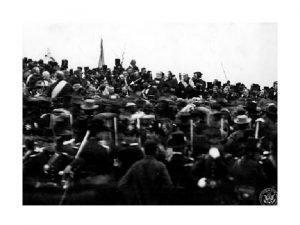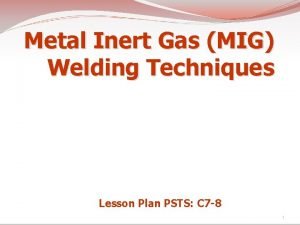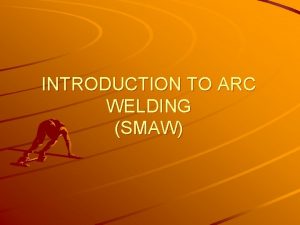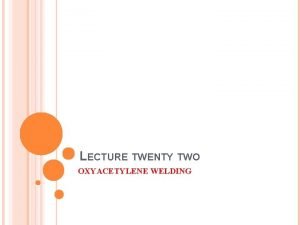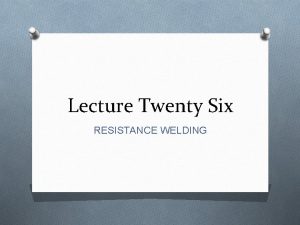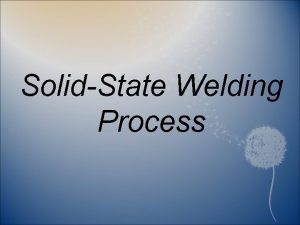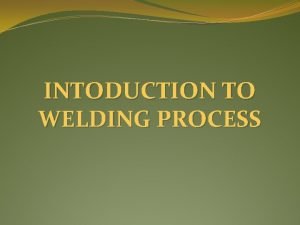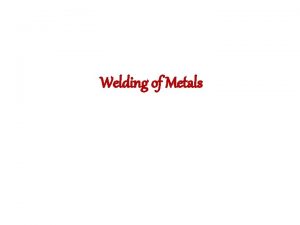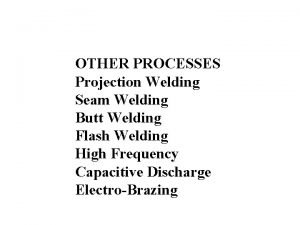Lecture Twenty Four SOLIDSTATE WELDING Introduction In solidstate









- Slides: 9

Lecture Twenty Four SOLID-STATE WELDING

Introduction In solid-state welding, coalescence of the part surfaces is achieved by: (1)pressure alone , or (2)heat and pressure. For some solid-state processes , time is also a factor. If both heat and pressure are used, the amount of heat by itself is not sufficient to cause melting of the work surfaces. In other words, fusion of the parts would not occur using only the heat that is externally applied in these processes. In some cases, the combination of heat and pressure, or the particular manner in which pressure alone is applied, generates sufficient energy to cause localized melting of the faying surfaces. Filler metal is not added in solid-state welding.

GENERAL CONSIDERATIONS IN SOLID-STATE WELDING In most of the solid-state processes , a metallurgical bond is created with little or no melting of the base metals. To metallurgically bond two similar or dissimilar metals, the two metals must be brought into intimate contact so that their cohesive atomic forces attract each other. In normal physical contact between two surfaces, such intimate contact is prohibited by the presence of chemical films, gases, oils, and so on. In order for atomic bonding to succeed, these films and other substances must be removed. In fusion welding (as well as other joining processes such as brazing and soldering), the films are dissolved or burned away by high temperatures, and atomic bonding is established by the melting and solidification of the metals in these processes

But in solid-state welding, the films and other contaminants must be removed by other means to allow metallurgical bonding to take place. In some cases, a through cleaning of the surfaces is done just before the welding process; while in other cases, the cleaning action is accomplished as an integral part of bringingthepartsurfacestogether. Tosummarize, theessentialingredientsforasucc essful solid-state weld are that the two surfaces must be very clean, and they must be brought into very close physical contact with each other to permit atomic bonding.

Welding processes that do not involve melting have several advantages over fusion welding processes. If no melting occurs, then there is no heataffected zone, and so the metal surrounding the joint retains its original properties. Many of these processes produce welded joints that comprise the entire contact interface between the two parts, rather than at distinct spots or seams, as in most fusion –welding operations. Also , some of these processes are quite applicable to bonding dissimilar metals , without concerns about relative thermal expansions, conductivities, and other problems that usually arise when dissimilar metals are melted and then solidified during joining.

SOLID STATE-WELDING PROCESSES Forge Welding: Forge welding is of historic significance in the development of manufacturing technology. The process dates from about 1000 BCE, when blacksmiths of the ancient world learned to join two pieces of metal. Forge welding is a welding process in which the components to be joined are heated to hot working temperatures and then forged together by hammer or other means. Considerable skill was required by the craftsmen who practicedit in order to achieve a good weld by present-day standards. The process may be of historic interest.

Cold Welding: Cold welding (CW) is a solid-state welding process accomplished by applying high pressure between clean contacting surfaces at room temperature. The faying surfaces must be exceptionally clean for CW to work, and cleaning is usually done by degreasing and wire brushing immediately before joining. Also, at least one of the metals to be welded, and preferably both, must be very ductile and free of work hardening. Metals such as soft aluminum and copper can be readily cold welded. The applied compression forces in the process result in cold working of the metal parts, reducing thickness by as much as 50%; but they also cause localized plastic deformation at the contacting surfaces, resulting in coalescence. For small parts, the forces may be applied by simple hand-operated tools. For heavier work, powered presses are required to exert the necessary force. No heat is applied from external sources in CW , but the deformation process raises the temperature of the work somewhat. Applications of CW include making electrical connections.

Roll Welding: Roll welding is a variation of either forge welding or cold welding, depending on whether external heating of the workparts is accomplished prior to the process. Roll welding (ROW) is asolid-state welding process in which pressure sufficient to cause coalescence is applied by means of rolls, either with or without external application of heat. The process is illustrated in Figure 24. 1. If no external heat is supplied, the process is called cold-roll welding; if heat is supplied, the term hot-roll welding is used. Applications of roll welding include cladding stainless steel to mild or low alloy steel for corrosion resistance, making bimetallic strips for measuring temperature.

Figure 24. 1
 Four score and seven years ago means
Four score and seven years ago means It's five to eight
It's five to eight How long is four score and seven years
How long is four score and seven years 01:640:244 lecture notes - lecture 15: plat, idah, farad
01:640:244 lecture notes - lecture 15: plat, idah, farad Brazing weld symbol
Brazing weld symbol Welding lesson plans
Welding lesson plans Introduction to biochemistry lecture notes
Introduction to biochemistry lecture notes Introduction to psychology lecture
Introduction to psychology lecture Introduction to algorithms lecture notes
Introduction to algorithms lecture notes Introduction of arc welding
Introduction of arc welding


